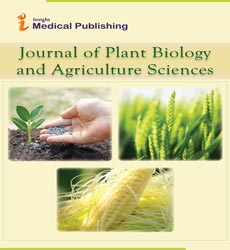The Capacity to Perform Photosynthesis and Store Starch
Khadijeh Mozaffari*
- *Corresponding Author:
- Khadijeh Mozaffari
Department of Plant and Environmental Sciences, New Mexico State University, Las Cruces, NM 88003, USA
E-mail: mozafari@nmsu.edu
Received date: August 05, 2021; Accepted date: August 19, 2021; Published date: August 26, 2021
Citation:Dr. Mozaffari K (2021) The Capacity to Perform Photosynthesis and Store Starch. J Plant Bio Agric Sci Vol.5 No.6:e001
Introduction
Plant cells are eukaryotic cells present in green plants,photosynthetic eukaryotes of the realm Plantae. Theirunmistakable components incorporate essential cell dividerscontaining cellulose, hemicelluloses and gelatin, the presence ofplastids with the capacity to perform photosynthesis and storestarch, a huge vacuole that manages turgor pressure, theshortfall of flagella or centrioles, besides in the gametes, and aone of a kind technique for cell division including thearrangement of a cell plate or phragmoplast that isolates thenew little girl cells. Plant cells have cell dividers, developedexternal the cell film and made out of cellulose, hemicelluloses,and gelatin. Their arrangement stands out from the cell dividersof organisms, which are made of chitin, of microorganisms,which are made of peptidoglycan and of archaea, which aremade of pseudopeptidoglycan. By and large lignin or suberin aredischarged by the protoplast as optional divider layers inside theessential cell divider. Cutin is emitted outside the essential celldivider and into the external layers of the optional cell mass ofthe epidermal cells of leaves, stems and other over the groundorgans to frame the plant fingernail skin. Cell dividers performnumerous fundamental capacities. They give shape to frame thetissue and organs of the plant, and assume a significant part inintercellular correspondence and plant-microorganismcooperations. Many sorts of plant cells contain an enormousfocal vacuole, a water-filled volume encased by a layer known asthe tonoplast that keeps up with the cell's turgor, controlsdevelopment of atoms between the cytosol and sap, storeshelpful material, for example, phosphorus and nitrogen andreviews squander proteins and organelles. Particular cell-to-cellcorrespondence pathways known as plasmodesmata, happen aspores in the essential cell divider through which theplasmalemma and endoplasmic reticulum of adjoining cells areconstant. Plant cells contain plastids, the most striking beingchloroplasts, which contain the green-shaded color chlorophyllthat changes over the energy of daylight into synthetic energythat the plant uses to make its own food from water and carbondioxide in the process known as photosynthesis. Different kindsof plastids are the amyloplasts, specific for starch stockpiling,elaioplasts particular for fat stockpiling, and chromoplastsparticular for union and capacity of colors. As in mitochondria,which have a genome encoding 37 qualities,plastids have theirown genomes of around 100–120 extraordinary qualities andare deciphered as having emerged as prokaryoticendosymbionts living in the cells of an early eukaryoticprogenitor of the land plants and green growth. Cell division inland plants and a couple of gatherings of green growth, strikinglythe Charophytes and the Chlorophyte Order Trentepohliales,happens by development of a phragmoplast as a layout forbuilding a phone plate late in cytokinesis. The motile, free-swimming sperm of bryophytes and pteridophytes, cycads andGinkgo are the lone cells of land plants to have flagella like thosein creature cells, yet the conifers and blooming plants don't havemotile sperm and need the two flagella and centrioles.Parenchyma cells are living cells that have capacities going fromcapacity and backing to photosynthesis (mesophyll cells) andphloem stacking (move cells). Aside from the xylem and phloemin their vascular groups, leaves are made primarily out ofparenchyma cells. Some parenchyma cells, as in the epidermis,are particular for light entrance and centering or guideline of gastrade, however others are among the most un-specific cells inplant tissue, and may stay totipotent,fit for isolating to delivernew populaces of undifferentiated cells, all through their lives.Parenchyma cells have dainty, penetrable essential dividersempowering the vehicle of little atoms among them, and theircytoplasm is liable for a wide scope of biochemical capacitieslike nectar discharge, or the assembling of auxiliary items thatdebilitate herbivory. Parenchyma cells that contain numerouschloroplasts and are concerned fundamentally withphotosynthesis are called chlorenchyma cells. Others, forexample, most of the parenchyma cells in potato tubers and theseed cotyledons of vegetables, have a capacity work.
Open Access Journals
- Aquaculture & Veterinary Science
- Chemistry & Chemical Sciences
- Clinical Sciences
- Engineering
- General Science
- Genetics & Molecular Biology
- Health Care & Nursing
- Immunology & Microbiology
- Materials Science
- Mathematics & Physics
- Medical Sciences
- Neurology & Psychiatry
- Oncology & Cancer Science
- Pharmaceutical Sciences
